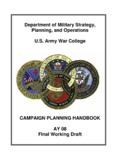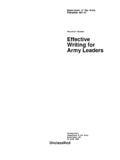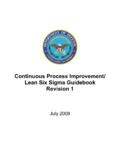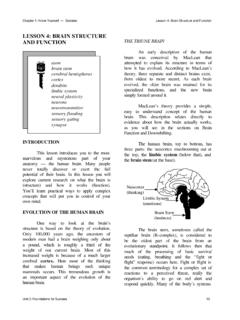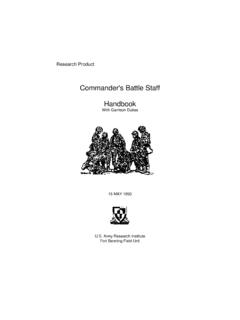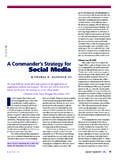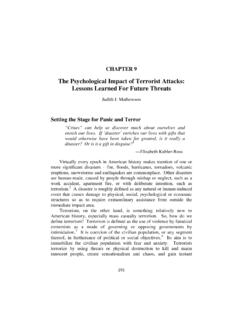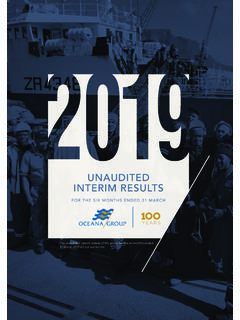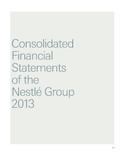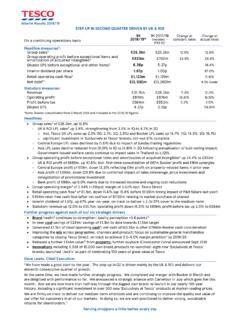Transcription of The Case for a Joint Military Decisionmaking Process
1 The Case for a Joint Military Decisionmaking Process Colonel Joseph Anderson, Army Brigade Commander, 2d Brigade (502d), 101st Airborne Division (AA), Fort Campbell, Kentucky Colonel Nathan K. Slate, Army Brigade Commander, 7th Field Artillery Brigade, Fort Sill, Oklahoma F OLLOWING OPERATION Eagle Claw, the failed attempt to rescue Embassy hos- tages held by the Iranian Revolutionary Guard in Although the distinction between what is art and what is science might appear 1980, Congress decided that the armed services superfluous, it is anything but.
2 Determining would need help in overcoming the historic aversion what is art and what is science is the to working together as Joint The 1986 basis for almost all of the differences Goldwater-Nichols Act provides a framework in law between the services. to facilitate a more Joint perspective by reorganiz- ing the Joint Chiefs of Although the services have made great strides since 1986, they still have against asymmetric threats such as terrorism with- major hurdles to overcome. out fully synchronous Joint operations. Therefore, it Why cannot a staff of senior interservice offic- is time for the services to set aside parochial differ- ers function together as an effective team?
3 Varying ences and come together to create a Joint concept experience and training in Military Decisionmaking is for use in the COE. a significant factor, but there is more. The armed services do not have a Joint Military Decisionmaking What's in a Name? Process (JMDMP). Each clings to its own parochial Over time there has been some movement toward method of staff planning, and each approaches mili- developing a Joint concept. The Marine Corps tary- Decisionmaking procedures in radically differ- has adopted a Military Decisionmaking Process ent Such differences ensure friction and ob- (MDMP) similar to the Army's.
4 The Air Force struct Joint interoperability. An agreed-on JMDMP uses a rather eclectic mixture of existing approaches must be taught in the individual service schools if the to the Process . The Navy, a late entry into the services are to ever have truly effective Joint staffs. mix, has its own spin on the Process , which it calls The events of 11 September 2001 demonstrate the the commander's estimate of the situation (CES). complexity of the contemporary operating environ- Each service's approach has merit, and on the sur- ment (COE).
5 We cannot win the ongoing war face, problems appear easy to correct. More than Military REVIEW September - October 2003 11. 5. Analysis of ECOAs and own COAs. We cannot win the ongoing war against 6. Comparison of own COAs. asymmetric threats such as terrorism without 7. Stating the decision. fully synchronous Joint operations. Therefore, The Army and Marine Corps' approach involves it is time for the services to set aside parochial the following seven steps: differences and come together to create a 1. Mission receipt.
6 Joint concept for use in the COE. a. Area of operation (AO)/area of interest (AI). enough doctrine exists to cover all requirements. The b. Terrain and weather analysis. hitch is in creating an agreed-on lexicon so all ser- c. Threat models (intelligence preparation of vices will use the same words to describe the same the battlespace (IPB), steps 1 through 3). types of tasks. 2. Mission analysis (CES, steps 1 through 3), in- Although the distinction between what is art and cluding pertinent threat COAs (initial phase of the what is science might appear superfluous, it is any- IPB, step 4).
7 Thing but. Determining what is art and what is sci- 3. Develop COAs (CES, step 4). ence is the basis for almost all of the differences a. Refine threat COAs. between the services. For example, in the Army's b. Draft event template. MDMP, staff procedures are considered science 4. Analyze COAs (CES, step 5). because a litany of tenets, principles, and standard a. Prioritize threat COAs. operating procedures govern them. And, in the b. Event template. Army's MDMP, the commander's decision and di- c. Identify intelligence requirements.
8 Rection are considered art because they are a cul- 5. Compare COAs (CES, step 6). mination of the commander's intuition based on his a. Collection plan. experience. b. Intelligence synchronization matrix. As a name, the Army's MDMP could allude to 6. Decision and COA approval (CES, step 7). tactical-level operations and, therefore, might not 7. Write operations order (OPORD). lend itself to the broader aspects of strategic and The major difference between the two processes operational missions. On the other hand, the Navy's lies in how each treats intelligence.
9 The Army's ap- CES Process is often seen as being too commander- proach relies heavily on detailed staff preparation as centric and inappropriately art-heavy. The easiest the Process begins on receipt of the mission. The resolution of the problem is for all of the services Navy's approach hand waves the IPB, perhaps to agree on a new term that takes its roots in because the Navy commands the seas and feels that the Joint approach. Our recommendation is that it always has situational awareness. In a Joint and the term commander's estimate of the situation, combined arena, the IPB Process is crucial.
10 The staff which is step 4 of the Navy's concept-development must perform the IPB up front if the Joint Process phase, should replace the Army term Military is to be successful. The Joint CES Process must in- Decisionmaking Process , and all of the services clude this adjustment. should begin using the same terminology to describe The Air Force approach seems to take its origins the same from an older Army model that used templates and checklists to help the staff develop the MDMP. The What Does This Mean? Air Force's CES includes the following six steps: Deciding how to synthesize the procedure is more 1.
